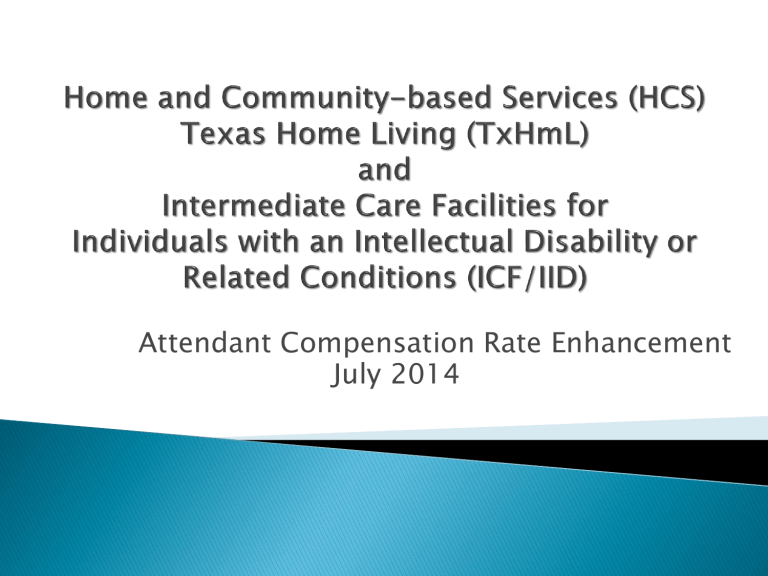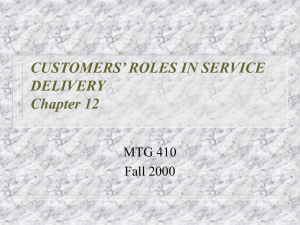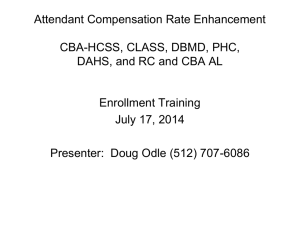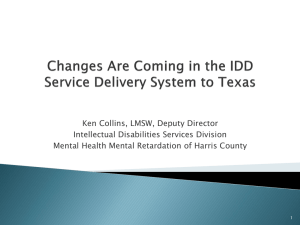HCS/TxHmL and ICF/IID training presentation

Attendant Compensation Rate Enhancement
July 2014
Overview
Website
Enhancement Levels
Who can be counted as an attendant?
Time studies
Allowable compensation
Non-day habilitation services versus day habilitation services
Conditions of participation for day habilitation services
Group versus individual
Special requirements for groups
Spending requirements and recoupments
Non-Day Habilitation Enrollment Worksheets
Day Habilitation Enrollment Worksheets
Enrollment Contract Amendment
Authorized representatives
Enrollment options
Notification of enrollment
Reporting requirements
What happens if I choose not to participate?
Miscellaneous
Where to go for help
Background.
Implemented September
1, 2010. 81st Texas
Legislature authorized
HHSC by means of its appropriations rider 67 to replace Fiscal
Accountability with a rate enhancement system to ensure prudent use of funding appropriated for the HCS, TxHmL and
ICF/IID programs.
Purpose. To incentivize providers to increase attendant compensation and to hold providers accountable for the expenditure of any enhancement funds.
Optional Participation.
Participation is voluntary.
Participation
Agreement. Contracted providers may choose to participate by submitting a signed
Enrollment Contract
Amendment choosing to enroll and indicating the level of enhanced add-on rate they desire to receive.
Day Habilitation versus
Non-Day Habilitation or
Residential Services.
For each component code, providers may choose to participate for non-day habilitation/residential services only, day habilitation services only, or both non-day habilitation/residential and day habilitation services.
Enrollment. Enrollment is held in July, prior to the rate year.
Levels. During the enrollment period, providers indicate a level of enhancement at which they
want to participate for non-day habilitation/residential services and a level of enhancement at which they want to participate for day habilitation services.
Component Codes.
Participation is determined at the component code level.
Spending Requirements.
Participating providers agree to spend 90 percent of their total attendant revenues, including their enhanced add-on rate revenues, on attendant compensation.
Compliance.
Compliance with the spending requirements will be determined using annual cost report data submitted by the provider.
Compliance will be determined separately for HCS/TxHmL and
ICF/IID and separately for non-day habilitation/residential and day habilitation services.
Recoupment.
Participants failing to meet their spending requirement will be subject to recoupment.
At no time will a participating provider’s attendant care rate after recoupment be less than the rate paid to providers not participating in the enhancement program.
Limited Funding. It is possible that the level requested by a provider will not be granted due to limited funding.
Grouping. Participating component codes controlled by a single entity can be aggregated within a program
(HCS/TxHmL or ICF/IID) to comply with the spending requirement.
Conditions of
Participation for Day
Habilitation. There are special conditions of participation that apply to each HCS, TxHmL and ICF/IID provider specifying its wish to have day habilitation services participate in the enhancement.
For rates, rules, forms, instructions, amendments and level awards refer to the Rate Analysis Website: http://www.hhsc.state.tx.us/rad/long-termsvcs/index.shtml
You will find a list of programs.
Click on the name of the program (i.e. HCS, TxHmL or
ICF/IID).
Locate "Rate Enhancement - Attendant Compensation".
Click on "View 2015 Rate Enhancement – Attendant
Compensation information".
For problems with downloading files see the website element “Problems with Downloading Excel and Word
Files?” before calling for help.
Providers will be given the opportunity to select the level of enhancement at which they want to participate for non-day habilitation services and for day habilitation services.
There are 25 levels of enhancement. Level 1 is $.05 above the non-participant rate. Each level increases by $.05. Level 25 is $1.25 above the non-participant rate.
Requested levels are granted as follows:
HHSC determines projected units of service for component codes requesting each enhancement level and multiplies this number by the enhancement rate add-on amount associated with that enhancement level.
HHSC compares the sum of the products to available funds.
If the sum of the products is less than or equal to available funds, all requested enhancements are granted.
Requested levels are granted as follows (cont.):
If the sum of the products is greater than available funds, preexisting enhancements are rolled over and, if funds remain available, new enhancements are granted beginning with the lowest level of enhancement and granting each successive level of enhancement until requested enhancements are granted within available funds.
A provider can request a reduction in level or to discontinue participation at any time.
Providers who withdraw or reduce are still responsible for meeting spending requirements on monies already received.
An attendant is the unlicensed caregiver providing direct assistance to consumers with
Activities of Daily Living and Instrumental
Activities of Daily Living. Attendants include direct care workers, direct care trainers and job coaches in the HCS, TxHmL and ICF/IID programs
HCS Supervised Living/Residential Support
Services (SL/RSS) attendants may perform some nonattendant functions. In such cases, the attendant must perform attendant functions at least 80 percent of his or her total time worked. Staff not providing attendant services at least 80 percent of their total time worked are not considered attendants.
HCS Supervised Living/Residential Support
Services (SL/RSS) attendants may perform some nonattendant functions. In such cases, the attendant must perform attendant functions at least 80 percent of his or her total time worked. Staff not providing attendant services at least 80 percent of their total time worked are not considered attendants.
Time studies must be performed for SL/RSS staff members that are not full-time attendants to determine if the staff member meets the 80% rule. Failure to perform the time studies will result in the staff not being considered attendants.
80% Rule in ICF/IID – attendants must perform attendant functions at least 80% of their total time worked to be counted as attendants.
Attendants
do not
include director, administrator, assistant director, assistant administrator, clerical and secretarial staff, professional staff, other administrative staff, licensed staff, attendant supervisors, cooks and kitchen staff, maintenance and grounds keeping staff, activity director, Qualified
Intellectual Disabilities Professionals (QIDPs), assistant QIDPs, direct care worker supervisors, direct care trainer supervisors, job coach supervisors, foster care providers, and laundry and housekeeping staff.
Attendants do include drivers for HCS SL/RSS and day habilitation and for ICF/IID.
Attendants do include medication aides for HCS
SL/RSS and for ICF/IID.
Attendant contract labor – nonstaff attendants.
Nonstaff refers to personnel who provide services to the facility intermittently, whose fee or compensation is not subject to employer payroll tax contributions and who perform tasks routinely performed by employees.
In the case of HCS Supported Home Living (SHL) and TxHmL Community Support Services (CSS), staff other than attendants may deliver attendant services and be considered an attendant during the time they are delivering attendant services if they must perform attendant services that cannot be delivered by another attendant to prevent a break in services. In such a situation, the staff person would be required to keep timesheets and only that time spent delivering attendant services on a fill-in basis would be reported as attendant time.
Except in the special circumstances described above, the attendant may not perform any nonattendant functions.
Goal is to get $ into the hands of lowest-paid staff to improve quality of care.
Must be used for HCS SL/RSS staff and for any
ICF/IID staff performing attendant functions less than 100% of their time but greater than
80% of their time. Staff members that perform attendant functions less than 100% of their time that do not perform a time study will not be considered an attendant for the
Attendant Compensation Rate Enhancement.
The minimum allowable duration for a time study is four weeks per year.
Randomly select one week per quarter.
A time study must be for 100% of the paid time of the staff, including vacation and sick leave, for the period covered by the time study.
The time study must show the employee's start and stop time, total hours worked and actual time worked in 30minute increments or less, and the functions performed.
Time sheets used in a time study must cover a full working day and cover all of the tasks and programs involved.
Allowable compensation in accordance with 1
Texas Administrative Code (TAC)
§355.103(b)(1) & (2), §355.722 (HCS/TxHmL) and §355.457 (ICF/IID)
Allowable contract labor costs as defined in 1
TAC §355.103(b)(2)(C).
Salaries/Wages:
Regular Paid Hours
Overtime
Bonuses
Cash Incentives/Awards
Paid Leave (e.g., sick, vacation, jury, etc.)
Mileage Reimbursement is limited to $$0.56 per mile Jan 1 – Aug 31, 2014
Employee Benefits/Insurance:
Accrued Vacation and Sick Leave*
Employer-Paid Health/Medical/Dental
Premiums
Employer-Paid Disability Insurance
Premiums
Employer-Paid Life Insurance Premiums
*Providers must maintain adequate documentation to substantiate that accrued leave costs reported one year as accrued Employee Benefits/Insurance are not also reported, either the same year or another year, as salaries and wages.
Employee Benefits/Insurance:
Employer-Paid Contributions to acceptable retirement funds/pension plans
Employer-Paid Contributions to acceptable deferred compensation funds
Employer-Paid Child Day Care
Payroll Taxes:
FICA/Medicare
Unemployment
Workers' Compensation Premiums
Workers' Compensation Paid Claims
Employee Benefits/Insurance:
Employer-Paid Health/Medical/Dental Paid Claims
Employer-Paid Disability Paid Claims
If any payroll taxes or benefits are allocated, an acceptable allocation summary is required.
No other costs can be reported as Employee
Benefits/Insurance. The contracted provider’s unrecovered cost of
◦ meals and room and board furnished to direct care employees,
◦ T-shirts,
◦ uniforms,
◦ plaques/trophies,
◦ gift certificates,
◦ job-related training reimbursements and job certification renewal fees
◦ food items, are not considered compensation for purposes of the Attendant Compensation
Rate Enhancement. Those costs are reported in other cost areas on the cost report.
All HCS, TxHmL and ICF/IID allowable cost rules pertaining to related-parties remain in effect. These rules include:
◦ Limiting related-party salaries to the model wage rate.
◦ Limiting related-party hours as per 1 TAC
§355.722 and §355.457
For the HCS and TxHmL programs, for each component code, providers may choose to participate for:
•
•
•
•
Non-day habilitation services only;
Day habilitation services only; or
Both non-day habilitation and day habilitation services.
There are different enrollment worksheets for non-day habilitation and day habilitation services.
Non-day habilitation services include:
HCS Supervised Living/Residential Support
Services;
HCS Supported Home Living;
TxHmL Community Support Services;
HCS and TxHmL
◦ Respite Services;
◦ Supported Employment Services; and
◦ Employment Assistance.
For the ICF/IID program, for each component code, providers may choose to participate for:
Residential services only;
Day habilitation services only; or
Both residential and day habilitation services.
There are different enrollment worksheets for residential and day habilitation services.
Residential services include all attendant services provided to Medicaid consumers by the ICF/IID except for day habilitation services.
The following conditions of participation apply to each HCS, TxHmL and ICF/IID provider specifying its wish to have day habilitation services participate in the
Attendant Compensation Rate Enhancement.
Report Attendant hours / compensation / taxes / benefits in Step 6c and Step 7
Report Non-Attendant hours / compensation
/ taxes / benefits in Step 6d and Step 7
Report Day Hab Administration hours / compensation / taxes / benefits in Step 6e and Step 7
Report Facility & Operations costs in Step 8.
Day habilitation costs cannot be combined and reported in one cost report item.
Report payments to the contractor in a single cost report item as directed in the cost report instructions
HHSC will allocate 50% of these payments to the attendant compensation cost area for inclusion with other allowable day habilitation attendant costs in order to determine the total
Attendant Compensation spending for day habilitation services.
The provider must ensure access to any and all records necessary to verify information submitted to HHSC on all reports. This includes ensuring access to records held
• by the provider,
• a related-party day habilitation provider and
• a non-related party day habilitation provider.
Failure to comply with the reporting and access requirements detailed above will result in recoupment of all attendant compensation rate enhancement funds associated with the day habilitation service for the provider for the reporting period in question.
What does it mean to participate as a group?
Component codes participating as a group are evaluated as meeting, or failing to meet, their spending targets in the aggregate for the specific program - this means that some component codes in the group can fail to meet their targets as long as other component codes in the group exceed their targets by enough to makeup the difference.
This is useful when you have some component codes in lower-wage areas and some in higherwage areas.
Rules limiting what component codes can be combined into a group appear in 1 TAC
§355.112(ee).
For component codes participating as a group, the enhancement level for a specific service (e.g., nonday habilitation services or day habilitation services) must be the same for all component codes.
New Component Codes. If a provider whose component codes are participating as a group acquires a participating business from another provider, that business must participate as part of the new owner's group.
Voluntary Withdrawal. Providers whose component codes are participating as a group must request to withdraw all component codes in the group.
Terminated Component Codes. Component codes which have been terminated or undergone a change of ownership from the provider organization to another organization must complete an individual report (i.e., a
FINAL report) at the time of their termination or change of ownership and meet spending requirements as an individual component code. The aggregate analyses for annual reporting period will not include these component codes.
A participating provider's attendant compensation costs per unit of service must be greater than or equal to 90% of the provider's DADS attendant participating rate.
Recoupment – DADS will recoup the difference between your DADS attendant compensation revenue per unit of service multiplied by 0.90 and your compensation cost per unit of service for each unit of service provided to a DADS consumer during the rate year.
Your DADS attendant compensation rate after recoupment will not be lower than the nonparticipant rate for your program.
A provider will not be enrolled in the
Attendant Compensation Rate Enhancement at a level higher than it achieved on its most recently available, audited Cost Report used for Attendant Compensation Rate
Enhancement purposes. HHSC will issue a notification letter that informs a provider in writing of its enrollment limitations (if any) prior to the first day of the open enrollment period.
Request for Revision. A provider may request a revision of its enrollment limitation if the provider’s most recently available, audited
Cost Report does not represent its current attendant compensation levels.
Enrollment worksheets are available on our website to help you make your enrollment decisions.
1.
Allow providers to calculate spending requirements and potential differences between costs and revenues under the enhancement for their component code or group.
2.
This information can be used by providers to help them make an informed decision about participation in the enhancement program for their HCS/TxHmL services or the ICF/IID program.
3.
There are different worksheets for the two programs and for non-day habilitation and day habilitation services in HCS/TxHmL and for residential and day habilitation services in ICF/IID.
4.
The worksheets are fully functional and will do all mathematical calculations for you.
5.
These worksheets are for your information only; do not return them to HHSC.
Select a reporting period that is representative of your typical caseload and staffing and that is as close to the open enrollment period as possible.
The reporting period may be of any length, although a minimum of one payroll period is recommended.
Examples:
◦ One payroll period in June
◦ One month (i.e., June 1 – June 30)
◦ Your most recent cost reporting period
To check for inconsistencies in data and errors in calculations, complete worksheets for two different reporting periods at least three months apart and compare the results. Large variances indicate either:
◦ An error in completing the worksheets or
◦ Large fluctuations in caseload and staff; such fluctuations should be taken into account when making your enrollment decision
see worksheets and instructions
A properly completed ECA must:
Be signed by an authorized representative as per the DADS Signature Authority
Designation Form applicable to the provider’s contract or ownership type.
Be received by the Rate Analysis by 5:00 p.m., July 31, 2014. No late forms, faxes or copies will be accepted.
A properly completed ECA must:
Indicate the provider’s enrollment decision for both non-day habilitation services and day habilitation services by entering a check mark or
“X” in the participation decision boxes.
Have an enhancement level indicated for non-day habilitation services and for day habilitation services.
A properly completed ECA must:
Reflect the correct 3-character component code and contracted provider name.
Be legible.
Any contracted provider not currently participating whose properly completed ECA is not received by Rate Analysis by 5:00 p.m. on July 31, 2014 will be a non-participant in the enhancement for fiscal year 2015.
Any participating contracted provider desiring to increase their level whose properly completed ECA is not received by Rate Analysis by 5:00 p.m. on
July 31, 2014 will not be considered for the requested increase.
Contracted providers who are already participants and do not desire to change their current participation levels or status do not need to submit a new ECA. Their levels will be rolled over as currently enrolled, within available funds.
For HCS/TxHmL
If you do not know who your authorized representative is, call the contract staff at
DADS.
If your authorized representative is not available, you need to make arrangements with DADS as soon as possible to add an additional authorized representative.
For ICF/IID
If you do not know who your authorized representative is, call: your DADS contract manager.
If your authorized representative is not available, you need to make arrangements with DADS as soon as possible to add an additional authorized representative.
HHSC Rate Analysis will post on its website a list of contracted providers, their enrollment status (i.e., participant or nonparticipant), group number (if applicable) and enhancement level awarded by
September 17, 2014. This will be the only notification of enrollment status provided by Rate
Analysis.
Rate Analysis Website:
http://www.hhsc.state.tx.us/rad/index.shtml
•
•
•
•
•
•
Click on "Long-Term Services and Supports".
Next you will find a list of programs.
Click on the name of the program (i.e. HCS).
Locate "Rate Enhancement - Attendant
Compensation".
Click on “View 2015".
Click on “Participation Status – Levels
Awarded.”
Compliance with Attendant Compensation Rate
Enhancement spending requirements will be determined through analysis of the provider’s annual Medicaid cost report.
Providers who begin participation on a date other than the 1 st day of their fiscal year or who end participation before the end of their fiscal year will be required to submit an
Accountability Report – Multipurpose (ARM) to allow HHSC to analyze their compliance with
Attendant Compensation Rate Enhancement spending requirements for that fiscal year.
You receive the same base rate as a participant with no enhancements.
You have no spending requirements.
It might be harder to become a participant in future years. The granting of enhancements is limited to available funding and participating component codes will receive priority consideration when future enhancements are awarded.
You still have to complete cost reports.
Attendant compensation component of your
DADS payment rate is frozen, except for increases necessary to cover mandated minimum wage levels and changes explicitly mandated by the Texas legislature.
What if I terminate my component code during the year?
The component code is placed on vendor hold until an acceptable FINAL ARM Report is received.
The FINAL ARM Report is used to determine if spending requirements were met.
Recoupment will result if spending requirements were not met. Spending requirements are determined on an individual basis for the component code.
What if I change ownership during the year?
The previous owner is placed on vendor hold until an acceptable FINAL ARM Report is received.
The FINAL ARM Report is used to determine if spending requirements were met by the previous owner.
Recoupment of the previous owner will result if spending requirements were not met. Spending requirements are determined on an individual basis for the component code.
Participation status of the previous owner will confer to the new owner.
What if I voluntarily withdrawal from the rate enhancement?
The withdrawal becomes effective the month after receipt by Rate Analysis of the written request sent by certified mail.
No placement of vendor hold.
Participating provider must submit a FINAL ARM
Report to determine if spending requirements were met.
Recoupment will result if spending requirements were not met.
What do I have to do to get paid my enhancement? How will the billing system handle recoupments?
If you are a participant, you should automatically get your new rate when you bill for units of service provided after
September 1, 2015. It is possible that first and second billings will need to be adjusted retroactively to reflect enhancement level.
Recoupments will be withheld from your first vendor payment after the determination of your recoupment amount. Recoupments will be considered adjustments to prior billings. If your component code is terminated or sold, your last vendor payment will be held by DADS until a FINAL Report is submitted and any recoupments determined/processed.
What if I want to change my enhancement participation level?
Provider may choose to lower its enhancement participation level at any time during the rate year; enhancement levels cannot be increased until the next open enrollment period.
Providers must request changes to their enhancement levels in writing. The enhancement level will be changed effective the month after receipt of the written request by
Rate Analysis.
Providers that fail to meet their enhancement requirements in a prior period have their enrollment in the Attendant
Compensation Rate Enhancement limited to the level they achieved in the prior period.
If a required report is not received by its due date, the provider will be placed on vendor hold and all funds associated with the enhancement will be recouped. If the required report is not received within a year of its due date, any recoupments due to nonsubmittal of the report are made permanent, and the vendor hold relating to the report is released.
If the provider fails to repay the amount due or fails to submit an acceptable payment plan within 60 days of notification of the recoupment, HHSC or its designee may collect recoupments owed by a provider from other DADS component codes controlled by the provider
Brand new entities will be sent an ECA to complete upon notification of HHSC by DADS of the existence of the new entity. These entities must submit a completed ECA within
30-days of notification by HHSC if they want to enroll in the enhancement. If enrollment levels were limited for the population during the open enrollment due to limited availability of funds, the same limitation applies to new entities.
Contact:
Phone: Rate Analyst (512) 730-7463
E-mail: RAD-LTSS@hhsc.state.tx.us
Mail Contact:
Regular Mail:
Texas Health & Human Services Commission
Rate Analysis Dept., Mail Code H-400
P.O. Box 149030
Austin, Texas 78714-9030
Special Delivery:
Texas Health & Human Services Commission
Rate Analysis Dept., Mail Code H-400
4900 North Lamar Blvd.
Austin, TX 78751-2316
Rate Analysis Website: http://www.hhsc.state.tx.us/rad/long-termsvcs/index.shtml
Verify receipt of completed ECAs:
Rate Analysis (512) 707-6094
Signator Questions:
HCS/TxHmL – DADS Contract Administration
ICF/IID – your DADS contract manager





